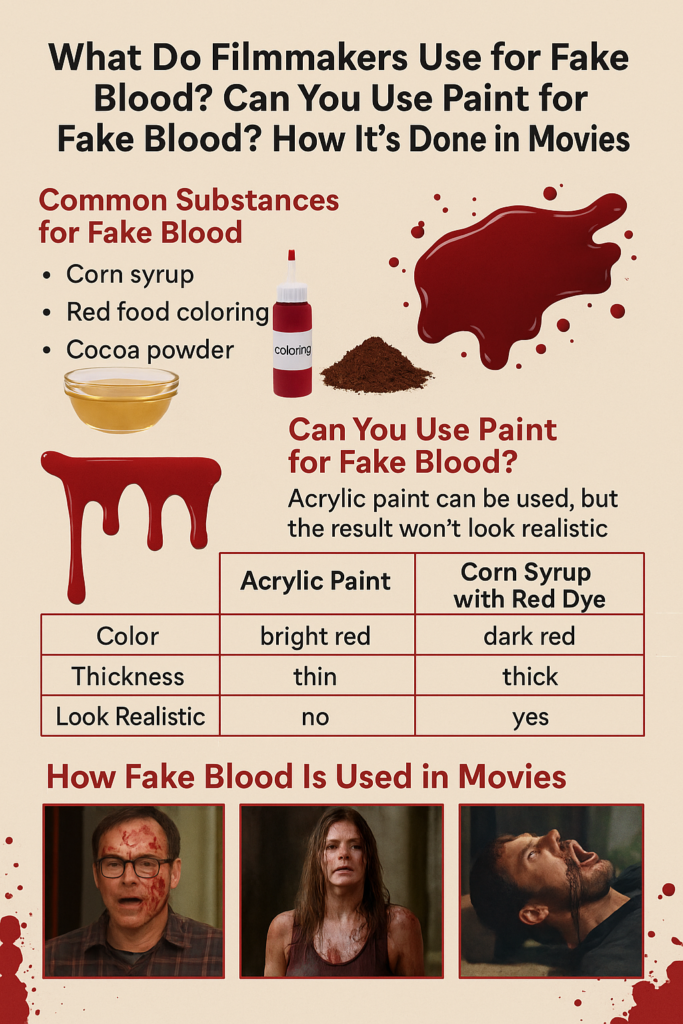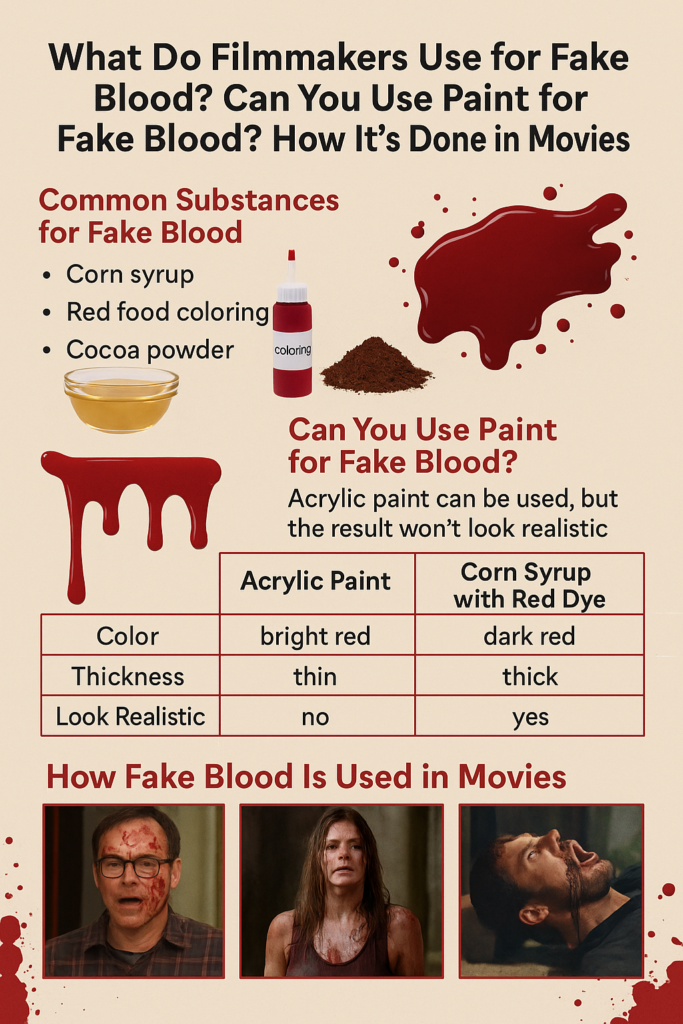
🎭 Introduction: The Role of Fake Blood in Filmmaking
Fake blood has long been one of the most iconic tools in the filmmaker’s kit. Whether you’re shooting a horror flick, war drama, or action sequence, the right blood effect adds realism, emotion, and impact to the scene.
But have you ever wondered how it’s made? Or whether you can use something as simple as paint? In this guide, we’ll break down everything you need to know — including ingredients, safety, usage techniques, DIY recipes, and famous examples in film history.
🧪 What Is Fake Blood Made Of?
Traditionally, fake blood has been created using household or food-safe ingredients that offer the right color, texture, and shine. Here are the most common ingredients:
| Ingredient | Purpose |
|---|---|
| Corn syrup | Provides viscosity and shine. |
| Chocolate syrup | Darkens blood, used in black-and-white films. |
| Red food coloring | Adds the iconic red hue. |
| Dish soap | Helps clean up easily from skin and costumes. |
| Cocoa powder/Instant coffee | Adjusts color tone and adds realism. |
These ingredients are safe on skin and camera-friendly, making them ideal for practical effects.

Find fake blood -Amazon
🎨 Can You Use Paint Instead of Fake Blood?
Using color paint as fake blood is not recommended, especially when it comes in contact with skin or fabric.
❌ Why Not Paint?
- Not skin-safe: Acrylic and oil paints often contain toxic chemicals.
- Poor texture: Paint lacks the fluid, sticky consistency of real blood.
- Unrealistic on camera: Paint dries unnaturally and tends to crack or flake.
👉 When it can be used: For props or background elements not interacting with actors, paint might be suitable.
🌈 Best Dyes and Colorants for Fake Blood
When making fake blood, choosing the right dye is crucial. Here are some options:
| Dye Type | Pros | Cons | Ideal For |
|---|---|---|---|
| Red food coloring | Easily accessible, mixable | Can stain fabrics | General effects |
| Powdered red lake dye | Rich, deep hues | Harder to find | Professional film sets |
| Kool-Aid/drink mix | Edible, colorful | Sweet smell, may attract insects | Mouth-safe scenes |
| Beetroot juice | Natural, organic | Unstable color, short shelf life | Experimental or eco-friendly sets |
Pro Tip: Always do a skin patch and fabric test to avoid allergic reactions or permanent stains.
🎥 How Fake Blood Is Used in Movies
Fake blood is used creatively depending on the desired effect. Here are the common techniques:
- Squib Explosions
Small pyrotechnic devices paired with blood packs to simulate gunshots. - Blood Tubes and Pumps
Tubes hidden in clothing or prosthetics deliver controlled blood splatter. - Makeup Application
Blood is dabbed or splashed using sponges, brushes, or droppers. - Post-Production VFX
Digital blood is added for enhanced realism or correction.

Find fake blood -Amazon
🎬 Famous Examples of Fake Blood in Film History
| Movie | Technique Used |
|---|---|
| Psycho (1960) | Chocolate syrup used in the iconic black-and-white shower scene. |
| Evil Dead series | Excessive use of corn syrup and red dye for comic gore. |
| Kill Bill (2003) | High-pressure blood tubes for dramatic stylized geysers. |
| Saving Private Ryan (1998) | Squibs with realistic blood tone for war injuries. |
📊 Comparison Table: Fake Blood Materials
| Material | Pros | Cons | Best Use Cases |
|---|---|---|---|
| Corn syrup + dye | Realistic, safe on skin | Sticky, attracts insects | All-purpose fake blood |
| Chocolate syrup | Great in B&W, cheap | Not red | Classic films, budget projects |
| Red food coloring | Easy to get, mixable | May stain | DIY blood, general effects |
| Acrylic paint | Durable, bright | Unsafe on skin, unrealistic | Non-living props and props only |
| Beetroot juice | Organic, natural | Unstable, short shelf life | Eco-shoots, edible blood |
🍽️ Can Fake Blood Be Eaten?
Yes — but only if made with food-grade ingredients. For safe oral use:
- Use corn syrup, Kool-Aid, red food dye, and peppermint extract.
- Avoid any non-edible colorants or commercial SFX blood unless labeled as food-safe.
🛑 Risks of Ingesting Fake Blood:
- Upset stomach due to sugar
- Allergic reactions
- Temporary staining
- Choking if too thick
Safety Tip: Always spit rather than swallow, and inform your cast about ingredients beforehand.

Find fake blood -Amazon
💉 How Fake Injection Shots Are Filmed
Fake injections are a staple in medical dramas and thrillers. They are executed using clever tricks:
🎭 Methods Used:
- Retractable Prop Needles: The needle retracts into the syringe upon skin contact.
- Hidden Blood Packs: Fake blood is pre-applied or released during the shot.
- Camera Angles and Editing: Directors avoid showing direct penetration.
- Prosthetics: Sometimes a prop limb is used for realistic close-ups.
Important: Real needles or real blood are never used due to safety and ethical concerns.
🎨 Will Fake Blood Stain Hair and Costumes?
Yes. Fake blood can stain fabric, wigs, and real hair — especially when left untreated.
⚠️ Stain Prevention Tips:
- Use barrier cream on skin before application.
- Spray costumes with fabric protectors.
- Test blood on a hidden section of wigs or clothing.
- Choose “no-stain” or washable formulas (e.g., Fleet Street brand for pros).
👁️ What if Fake Blood Gets in the Eye?
If fake blood enters the eye:
- Flush with clean water immediately for several minutes.
- If irritation continues, seek medical help.
- Avoid use near eyes unless it’s specialized “eye blood” like Kryolan’s formula.
🔧 DIY Fake Blood Recipe for Filmmakers
Here’s a safe and effective recipe for making your own fake blood at home:
🧴 Ingredients:
- 1 cup corn syrup
- 1 tbsp chocolate syrup
- 2 tbsp red food coloring
- 1 tsp dish soap
- A pinch of cocoa powder
🧪 Instructions:
- Mix all ingredients thoroughly.
- Adjust thickness with corn starch or water.
- Store in an airtight container in the refrigerator.
✅ Safe on skin
✅ Washable
✅ Edible (in small amounts)

Find fake blood -Amazon
💡 Pro Tips for Using Fake Blood Effectively
| Tip | Why It Matters |
|---|---|
| Match lighting | Blood color changes under different lights (especially blue). |
| Test viscosity | Adjust with water for drips or starch for clots. |
| Pre-test staining | Always check on fabric or props before large-scale use. |
| Body-temperature blood | Feels more realistic and flows better on actors. |
🧼 How to Remove Fake Blood from Skin, Hair, and Costumes
| Surface | Removal Method |
|---|---|
| Skin | Warm water + dish soap; gently scrub with sponge. |
| Hair | Use conditioner and warm water; comb gently. |
| Clothing | Rinse with cold water, pre-treat with stain remover, and machine wash. |
| Costumes | Spray protectants before filming or use disposable layers for extreme effects. |
🧾 Final Thoughts
Fake blood remains an essential visual tool in the world of cinema. From slasher films to intense battle scenes, it helps bring realism, fear, and drama to life on screen. Whether you’re an indie filmmaker or content creator, understanding its composition, safety, and usage techniques ensures professional results without risk.
And while it might be tempting to reach for red paint, nothing beats a well-crafted, skin-safe fake blood formula made from food-grade ingredients.
Find Fake Blood on Amazon
👉 Check Price & Options
About Me:
Hi, I’m Sujith — a content creator passionate about film production, visual effects, and practical tools for indie filmmakers. Through this blog, I aim to empower creatives with hands-on resources and insider knowledge.
Meta Description:
Discover how fake blood is made, used, and safely applied in movies. Explore ingredients, safety tips, and famous examples with comparison tables and DIY recipes.
Affiliate Disclosure:
This post may contain affiliate links. If you make a purchase through these links, we may earn a small commission at no extra cost to you. This supports our blog and helps provide more filmmaking tips.

Find fake blood -Amazon